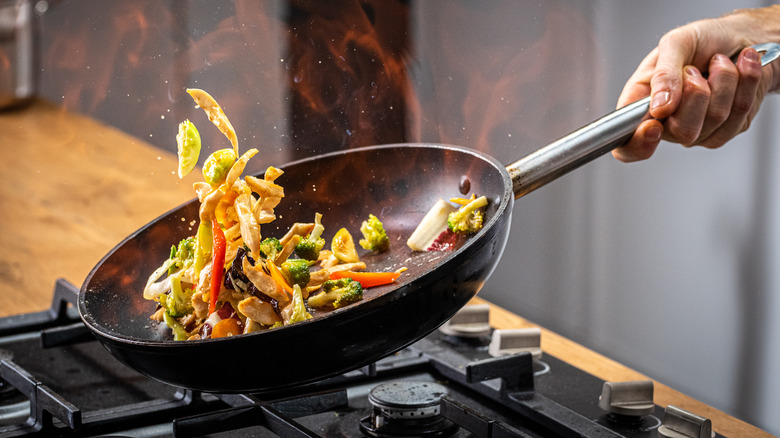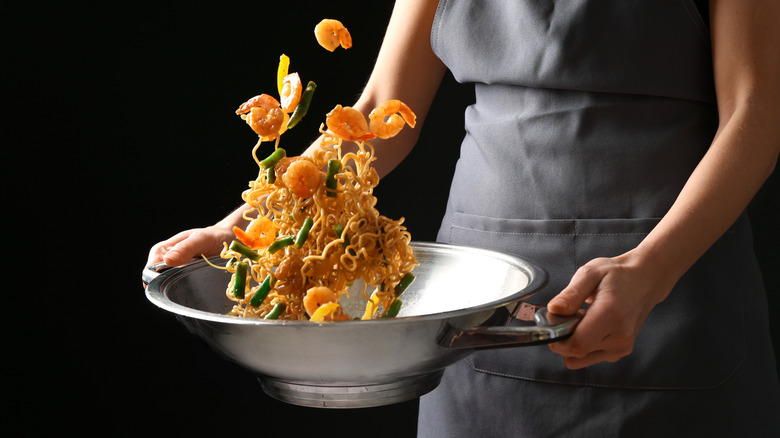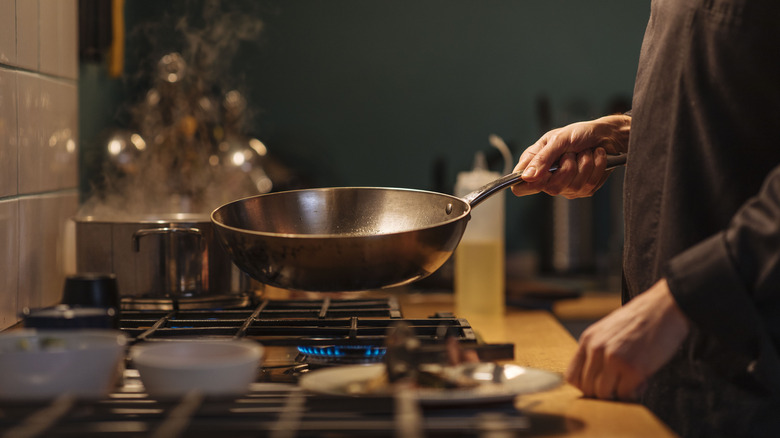The First Tip You Need To Know For Tossing Food In The Skillet Like A Pro
Tossing food in a skillet while cooking offers a lot of benefits. For one, it's an efficient way to keep food moving without the help of spatulas or spoons. Secondly, the technique ensures that your food is being cooked evenly while on high heat. And for the final bonus, pan-flipping is a flashy skill full of flair, so it's a fun experience for those that get to witness it too.
While this skill is beneficial to learn for its efficiency, it's also not the most practical choice. With a lack of proper practice, a pan-flip can easily lead to a mess. If you're someone who wants to learn how to pan-flip like a pro, we get it. It really helps bring that cool factor into the kitchen. But before you tackle this technique, it would be wise to dig into some of the most basic rules of food tossing first.
So let's start with one of the most important customs: only ever attempt this feat when using cookware with curved edges. This is an important parameter to keep in mind when tossing food for a few reasons and most have to do with safety and practicality.
The cookware you should be using when tossing food
One piece of cookware that is ideal for tossing food is a frying pan. This is a common tool chefs use to flip food, and that's for a reason. This vessel is curved on all sides, so whatever you're cooking will toss much more seamlessly than with other pans. This is because as you're flipping with a frying pan, the food will be lifted upwards into the air along the gentle upward curve of the pan's edges. As it's falling back down, it will safely be guided back by those edges too. This design effortlessly prevents flipped food from falling out and slipping to the ground. For those same reasons, woks are another good choice to use for a pan-flip.
Some cookware options to avoid when pan-flipping would be tools like a sauté pan which has tall, vertical edges. Any sort of cast-iron cookware would also not be the best choice as its weight will make it difficult to flip. Still, if you're feeling confident, we won't limit you to frying pans and woks. Just be aware that your flipping experience might not be as seamless.
While a pan-flip seems like a simple enough move, for most chefs the trick takes a lot of patience and practice. For those just starting out on this journey, we have a few more tips to share before you attempt this feat on your own.
Other tips for a flawless food flip
With just a few flips of a pan, your food can be seamlessly mixed into a complete dish. If you're ready to give this trick a try, here are some other ways to ensure it's a positive experience.
For starters, when you're gearing up to flip your pan, make sure you're using enough oil. You don't want anything to stick to the pan while you're flipping, so don't skimp on this ingredient. Next, remember to start off small with pan flipping. Don't try tossing an expensive stir fry on your first flip. Instead, start simple like by flipping your eggs in a frying pan, or something else that's also less substantial. This way, if things go south, you won't be crying over a dish you've been working on for hours that's now on the floor.
Lastly, when flipping food remember that there's much more to this trick than a flick of the wrist. It takes some finesse to flip a pan, so keep your movements small and tight to make it work. Keep your elbow locked to your side and keep your eye on the food. Now that you've got some basic pointers down, you can grab your pan of choice and get to flipping. Remember if you don't get it on the first try, don't be too hard on yourself. It's all a part of the inevitable learning process.


